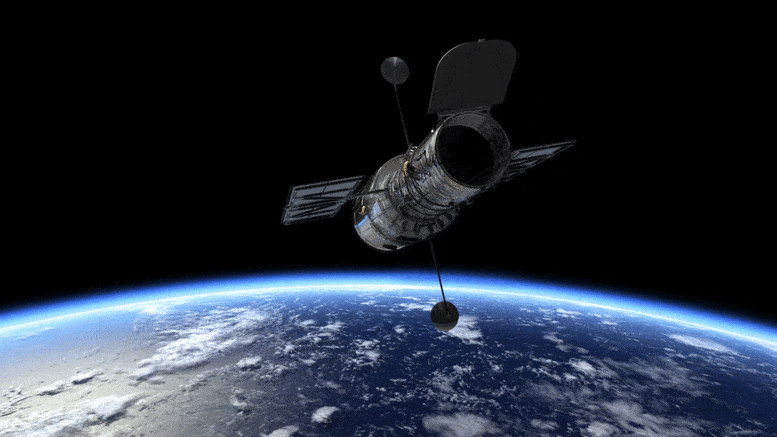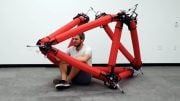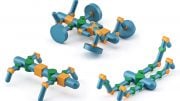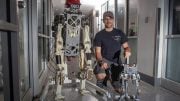
3D animation showing the Hubble Space Telescope over the Earth. Credit: ESA/Hubble (M. Kornmesser & L. L. Christensen)
A New Walking Robot Design
Researchers have created a cutting-edge walking robot that might revolutionize large space construction projects. They tested the feasibility of the robot for the in-space assembly of a 25m Large Aperture Space Telescope. Their findings were recently published in the journal Frontiers in Robotics and AI. Furthermore, a scaled-down version of the robot has shown potential for large-scale construction applications on Earth.
Maintenance and maintenance of massive structures are particularly important in space, where the circumstances are harsh and human technology has a limited lifetime. Robotics, autonomous systems, and extravehicular activities have all proven helpful for servicing and maintenance missions and have assisted the space community in conducting innovative research on a variety of space missions. Robotics and autonomous systems advancements provide a wide range of in-space services. This includes, but is not limited to, manufacturing, assembly, maintenance, astronomy, earth observation, and debris removal.
Due to the many hazards involved, relying just on human builders is insufficient, and current technologies are outdated.
“We need to introduce sustainable, futuristic technology to support the current and growing orbital ecosystem,” explained corresponding author Manu Nair, Ph.D. candidate at the University of Lincoln.
“As the scale of space missions grows, there is a need for more extensive infrastructures in orbit. Assembly missions in space would hold one of the key responsibilities in meeting the increasing demand.”
Nair and his colleagues presented a new, dexterous walking robotic system that could be used for in-orbit assembly missions in their paper. As a use case, the researchers tested the robot for the assembly of a 25m Large Aperture Space Telescope (LAST).
Assembling telescopes in orbit
Ever since the launch of the Hubble Space Telescope and its successor, the James Webb Space Telescope, the space community has been continuously moving towards deploying newer and larger telescopes with larger apertures (the diameter of the light collecting region).
Assembling such telescopes, such as a 25m LAST, on Earth is not possible with our current launch vehicles due to their limited size. That is why larger telescopes ideally need to be assembled in space (or in orbit).
“The prospect of in-orbit commissioning of a LAST has fueled scientific and commercial interests in deep-space astronomy and Earth observation,” said Nair.
To assemble a telescope of that magnitude in space, we need the right tools: “Although conventional space-walking robotic candidates are dexterous, they are constrained in maneuverability. Therefore, it is significant for future in-orbit walking robot designs to incorporate mobility features to offer access to a much larger workspace without compromising dexterity.”
E-Walker robot
The researchers proposed a seven degrees-of-freedom fully dexterous end-over-end walking robot (a limbed robotic system that can move along a surface to different locations to perform tasks with seven degrees of motion capabilities), or, in short, an E-Walker.
They conducted an in-depth design engineering exercise to test the robot for its capabilities to efficiently assemble a 25m LAST in orbit. The robot was compared to the existing Canadarm2 and the European Robotic Arm on the International Space Station. Additionally, a scaled-down prototype for Earth-analog testing was developed and another design engineering exercise was performed.
“Our analysis shows that the proposed innovative E-Walker design proves to be versatile and an ideal candidate for future in-orbit missions. The E-Walker would be able to extend the life cycle of a mission by carrying out routine maintenance and servicing missions post assembly, in space” explained Nair.
“The analysis of the scaled-down prototype identifies it to also be an ideal candidate for servicing, maintenance, and assembly operations on Earth, such as carrying out regular maintenance checks on wind turbines.”
Yet a lot remains to be explored. The research was limited to the design engineering analysis of a full-scale and prototype model of the E-Walker. Nair explained: “The E-Walker prototyping work is now in progress at the University of Lincoln; therefore, the experimental verification and validation will be published separately.”
Reference: “Design engineering a walking robotic manipulator for in-space assembly missions” by Manu Harikrishnan Nair, Mini Chakravarthini Rai and Mithun Poozhiyil, 14 October 2022, Frontiers in Robotics and AI.
DOI: 10.3389/frobt.2022.995813









Be the first to comment on "New Robot Design May Revolutionize How We Build Things in Space"